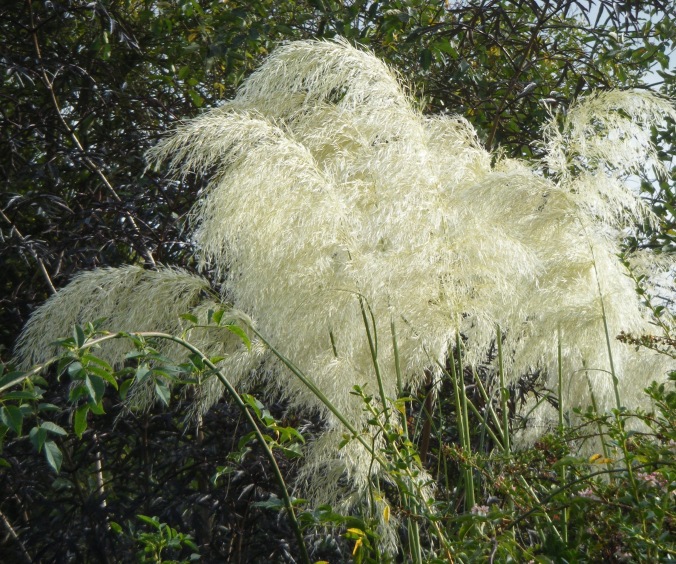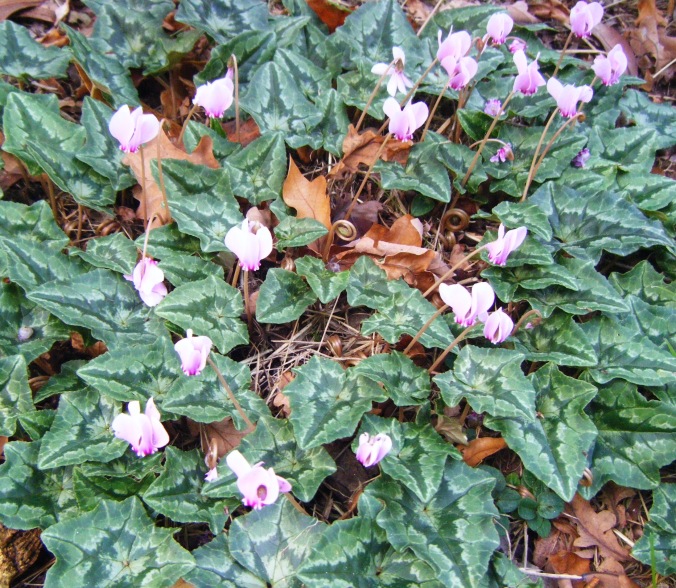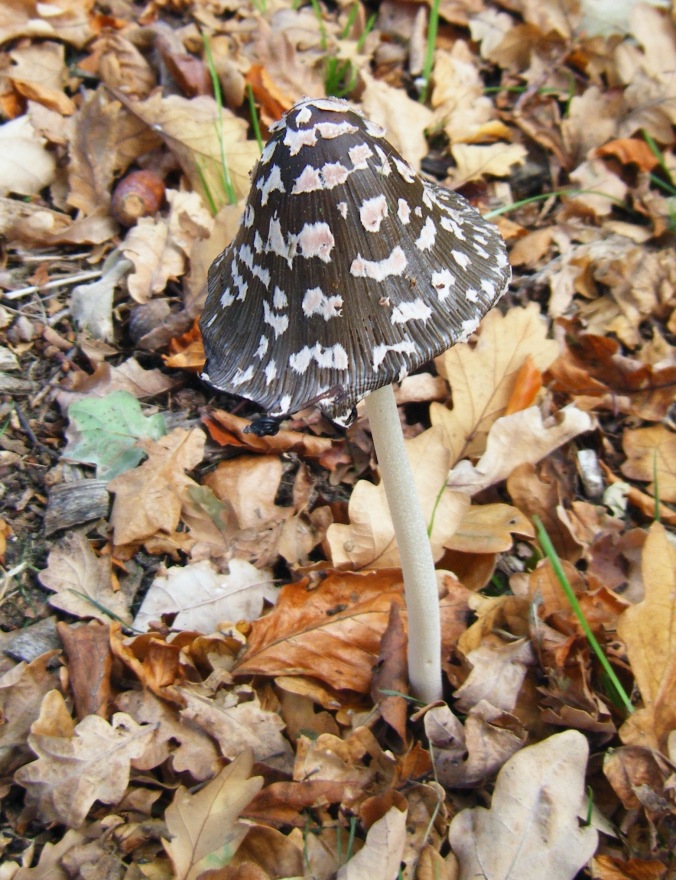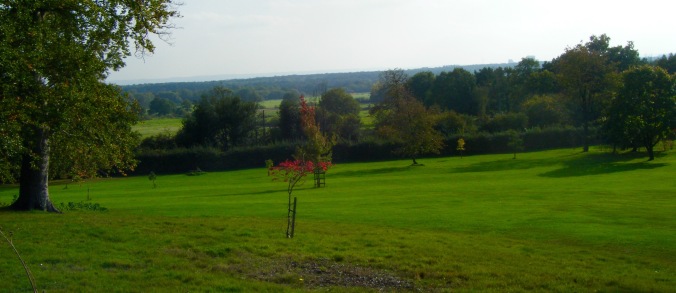October 15th was a glorious sunny Sunday and I was among several visitors who enjoyed an NGS open day at Timber Hill near Chobham in Surrey. Stepping through beautiful Autumn crocus Colchicum speciousus ‘Conqueror’ it is hard to believe that something of such beauty can be quite so poisonous.

Looking from the terrace of the house where statues surrounded by tiny pink roses dance and play, there was a definite feel of summer not yet over and a circle of Campanula fills a crack in the paving,

and pots are full of vibrant fuchsia, petunia and verbena. Even the sweet peas still look colourful, green and fresh.

Walking across the lawn I find a twiggy pheasant perched up in the Mulberry tree and for a brief moment mourn that my own fine specimen back home was recently felled by a storm. Wind chimes alert me to the present and for a very brief moment I hit fame as a visitor recognises me as “the blogger”. She is one of the Berkshire team, a county whose support in this project has been admirable.

The owners have lived and gardened here since 1951.The well-kept borders are full of colour; clumps of Tradescantia jostle for position next to Skimmia,

and the tall feathery plumes of Miscanthus appear silvery white.

Close by a butterfly, a Comma takes the opportunity to open its beautiful wings and bask in the sun.

There are several out this afternoon, Commas and Red Admirals together enjoy the drooping berries of the Himalayan honeysuckle Leycesteria formosa.

The garden softly merges into parkland. A Roebuck created by Cotswold based artist Katy Risdale (http://katerisdale.co.uk/) stands amongst the young trees, an area that helps link the garden to a maturer plantation further away.

The chunky leaves of Quercus affinis, an Oak from Mexico, appear scorchingly orangey red in the sunlight.

The feathery leaves of this large Maple are only just thinking of turning,

whilst this younger cousin Acer palmatum ‘Atropurpureum’ is already a fiery red

The woodland is not just about Autumn colour; there are over 200 camellias planted here. Not to be confused with the japonicas which flower in Spring, the Sasanquas, introduced to the West in 1869 by the Dutch traders often flower in the Autumn. Camellia sasanqua ‘Plantation Pink’ is such an example, graceful and single-flowered it smells very slightly.

Somewhat darker, the very prolific Camellia sasaqua ‘Hugh Evans’ is also scented,

whilst glorious ‘Gay Sue’ is considered to have the best fragrance of all.

The woodland floor is strewn with little hedgehog-like Sweet Chestnuts,

with occasional patches of cyclamen hederifolium, the ivy-leaves almost as decorative as the charming little flowers.

A good selection of fungi is very much in evidence, a subject of which I know so little. Luckily for me another visitor, out for the day from London seemed to be what I can only describe as a “fungophile” and helpfully identifies the varieties. This, upright and perfect, he explains was a Parasol Macrolepiota procera,

and when it all gets too much it then simply keels over.

The Shaggy Ink Cap goes by another splendid name of Lawyer’s Wig, Coprinus comatus,

They are all edible and my new-found friend enthuses about their culinary benefits and particularly enjoys this spongey type, the fleshy Orange Birch Bolete, Leccinum versipelle.

However, the Magpie ink cap Coprinopsis picacea is not so desirable being rather poisonous,

as is the familiar Fly Agaric Amanita muscaria.

He fears that these clusters may be Honey Fungus Armillaria mellea. There are apparently seven different strains of this deadly fungus, innocent-looking it spreads black bootlaces unseen underground ready to attack failing plants, which can often include many a fine old tree. Nature’s way but gardener’s nightmare.

Looking around in this lovely wood I am relieved to see that there are many healthy specimens. In a clearing I find a chiminea, probably not needed today; nevertheless a pleasant gesture if it should turn chilly. It is also touching to see the garden owner showing a less mobile visitor around in his motorised cart; most gardens have little access for the disabled. He pauses a moment to throw a log onto the lit fire.

Paths wind through the wood and through the clearing where I catch sight of the splendid 65 year old Liquidamber styraciflua.

Coming out of the wood you can see for miles. Swathes of dark green in an undulating landscape, it is an interesting fact to note that Surrey despite being commuter belt is the county with the highest concentration of trees in the UK.

I turn back towards the house and admire this mighty Oak, and cannot decide if it was planted as one and somehow grew into three.

Back by the house is a climbing Callicarpa bodinieri the Beautyberry; it is such an extraordinary colour, almost unnatural, but here it looks good intertwined with a vine.

Of course after such an interesting afternoon and with the journey home ahead, the day would have been incomplete without tea, so I joined my colleague from the NGS Berkshire team and sitting outside enjoyed a delicious piece of carrot cake.

Timber Hill is a garden with all-year-round interest and will be opening next year for yet more camellia (japonicas) and spring bulbs on the 17th March 2018, magnolias and spring blossom on 7th April and again for autumn delights on the 7th October. You should put it in your diary.
——-85——-
One is always learning- autumn flowering camellias!
LikeLike
So sorry to hear about the mulberry, what a blow! I wish my garden looked anything like as good as this one so late in the season..
LikeLike
Loving all these posts!
LikeLike
So much colour and not just the usual Autumn hues… very clever.
LikeLike
Camellias are so sweet especially when they are fragrant. This garden looks like it would be fun to tour by horse back. Lots of open space. It has a good feel.
LikeLike
I enjoy your blog immensely and look forward to each one. Thanks very much for doing it, it’s a joy and a breath of fresh air when stuck in central London on a grey day.
LikeLike
Beautiful !
LikeLike
I love your account of Timber Hill – it has added another dimension to my enjoyment of the garden! Berkshire NGS colleague!
LikeLike
Looked super -still lots of flower colour for the time of year-not to mention loads of glorious leaves.I dd not know about Autumn flowering Camellias…Thank you !
LikeLike
Pingback: 8 gorgeous garden visiting blogs | Blog at Thompson & Morgan